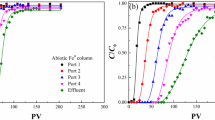Abstract
Combining denitrifying bacteria with sodium oleate-nanoscale zero-valent iron (SONZVI) has been proven to be effective for aqueous phase nitrate remediation. However, the effects of coexistent ions on nitrate reduction in a groundwater environment, which is at low temperature and under anoxic, light-excluded conditions, remain elusive. In this study, nitrate reduction by microbial-NZVI was evaluated via batch tests in the presence of common anions (SO4 2−, PO4 3− and Cl−) in two different environments: groundwater environment and room environment. The results showed that nitrate was largely reduced within 10 days in an SONZVI + cell reactor in the groundwater environment, while only 79 % of the nitrate was reduced over 10 days in the room environment. In the groundwater environment, the removal efficiency could be accelerated by chloride or phosphate, but inhibited by sulfate. There were mainly two reaction stages, which were chemical reduction degradation and denitrifying degradation. Pseudo-first-order kinetics was used to describe the two reaction stages. In the first stage, the existence of the anions inhibited nitrate degradation. The synergistic effects of these anions on nitrate removal followed the order of Cl−, SO4 2−, and PO4 3−. The results implied that using microbial-NZVI is a potential approach for in situ remediation of groundwater with nitrate contamination.






Similar content being viewed by others
References
Alowitz MJ, Scherer MM (2002) Kinetic of nitrate, nitrite and Cr(VI) reduction by iron metal. Environ Sci Technol 36:299–306
Biswas S, Bose P (2005) Zero-valent iron-assisted autotrophic denitrification. J Environ Eng 131(8):1212–1220
Chen YD, Jiang YP, Zhu YN et al (2013) Fate and transport of ethanol-blended dissolved BTEX hydrocarbons: a quantitative tracing study of a sand tank experiment. Environ Earth Sci 70(1):49–56
Cheng SF, Wu SC (2000) The enhance methods for the degradation of TCE by zero-valent metals. Chemosphere 41(8):1263–1270
Choe S, Chang YY, Hwang KY, Khim J (2000) Kinetics of reductive denitrification by nanoscale zero-valent iron. Chemosphere 41(8):1307–1311
Davis AP (2007) Field performance of bioretention: water quality. Environ Eng Sci 24(8):1048–1064
Doyle MP, Beuchat LR, Montville TJ (1997) Food microbiology fundamentals and frontiers. ASM Press, Washington, p 786
Fan X, Guan X, Ma J, Ai H (2009) Kinetics and corrosion products of aqueous nitrate reduction by iron powder without reaction conditions control. J Environ Sci 21(8):1028–1035
Foglra L, Briski F, Sipos L et al (2005) High nitrate from removal synthetic wasterwater with the mixed bacterial culture. Bioresour Technol 96(8):879–888
Harms H, Volkland HP, Repphun G et al (2003) Action of chelators on solid iron in phosphate-containing aqueous solution. Corros Sci 45(8):1717–1732
Hosseini SM, Ataie-Ashtiani B, Kholghi M (2011) Nitrate reduction by nano-Fe/Cu particles in packed column. Desalination 276:214–221
Huang YH, Zhang TC (2002) Kinetics of nitrate reduction by iron at near neutral pH. J Environ Eng Asce 128:604–611
Huang YH, Zhang TC (2004) Effects of low pH on nitrate reduction by iron powder. Water Res 38(11):2631–2642
Huang CP, Wang HW, Chiu PC (1998) Nitrate reduction by metallic iron. Water Res 32(8):2257–2264
Hwang YH, Kim DG, Shin HS (2011) Mechanism study of nitrate reduction by nano zero valent iron. J Hazard Mater 185:1513–1521
Joekar-Niasar V, Ataie-Ashtiani B (2009) Assessment of nitrate contamination in unsaturated zone of urban areas: the case study of Tehran, Iran. Environ Geol 57(8):1785–1798
Kim HH, Seagren EA, Davis AP (2003) Engineered bioretention for removal of nitrate from stormwater runoff. Water Environ Res 75:355–367
Lgourna Z, Warner N, Bouchaou L et al (2015) Elucidating the sources and mechanisms of groundwater salinization in the Ziz Basin of southeastern Morocco. Environ Earth Sci 73(1):77–93
Ma ZF, Lian XY, Zhang JB (2013) Simulation on remediation of 2,4-DNT in groundwater by zero-valent iron. China Environ Sci 33(5):814–820
Rina K, Datta PS, Singh CK et al (2014) Determining the genetic origin of nitrate contamination in aquifers of Northern Gujarat, India. Environ Earth Sci 71(4):1711–1719
Samuel CNT, Irene MCL (2013) Magnetic nanoparticles: essential factors for sustainable environmental applications. Water Res 47:2613–2632
Schnobrich MR, Chaplin BP, Semmens MJ et al (2007) Stimulating hydrogenotrophic denitrification in simulated groundwater containing high dissolved oxygen and nitrate concentrations. Water Res 41(9):1869–1876
Shin KH, Cha DK (2008) Microbial reduction of nitrate in the presence of nanoscale zero-valent iron. Chemosphere 72(8):257–262
Siantar DP, Schreier CG, Chou CS et al (1996) Treatment of 1,2-dibromo-3-chloropropane and nitrate-contaminated water with zero-valent iron or hydrogen/palladium catalysts. Water Res 30:2315–2322
Smith R, Ceazan M, Brooks M (1994) Autotrophic, hydrogenoxidizing, denitrifying bacteria in groundwater, potential agents for bioremediation of nitrate contamination. Appl Environ Microbiol 60:1949–1955
Son YH, Lee JK, Soong Y et al (2012) Heterostructured zero valent iron–montmorillonite nanohybrid and their catalytic efficacy. Appl Clay Sci 62–63:21–26
Su CM, Puls RW (2004) Nitrate reduction by zerovalent iron: effects of formate, oxalate, citrate, chloride, sulfate, borate, and phosphate. Environ Sci Technol 38:2715–2720
Tang SC, Lo IM (2013) Magnetic nanoparticles: essential factors for sustainable environmental applications. Water Res 47(8):2613–2632
Tang CL, Zhang ZQ, Sun XN (2012) Effect of common ions on nitrate removal by zero-valent iron from alkaline soil. J Hazard Mater 231–232:114–119
Wang W, Jin ZH, Li TL et al (2006) Preparation of spherical iron nanoclusters in ethanol–water solution for nitrate removal. Chemosphere 65:1396–1404
Yang GC, Lee HL (2005) Chemical reduction of nitrate by nanosized iron: kinetics and pathways. Water Res 39(5):884–894
Acknowledgments
This study was supported with a grant from the National High-Tech R&D Program of China (863 Program) (No.2012AA062603).
Author information
Authors and Affiliations
Corresponding author
Rights and permissions
About this article
Cite this article
Ma, Z., Yang, Y., Jiang, Y. et al. Effects of anions on bio-chemical degradation of nitrate in groundwater. Environ Earth Sci 74, 3985–3992 (2015). https://doi.org/10.1007/s12665-015-4454-z
Received:
Accepted:
Published:
Issue Date:
DOI: https://doi.org/10.1007/s12665-015-4454-z




